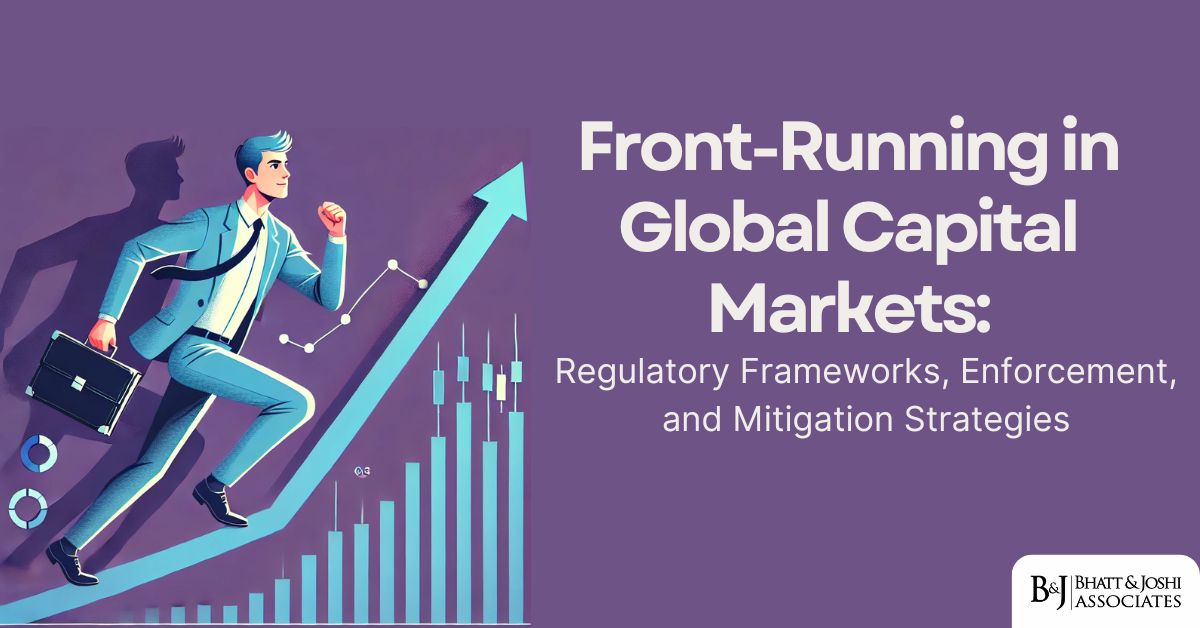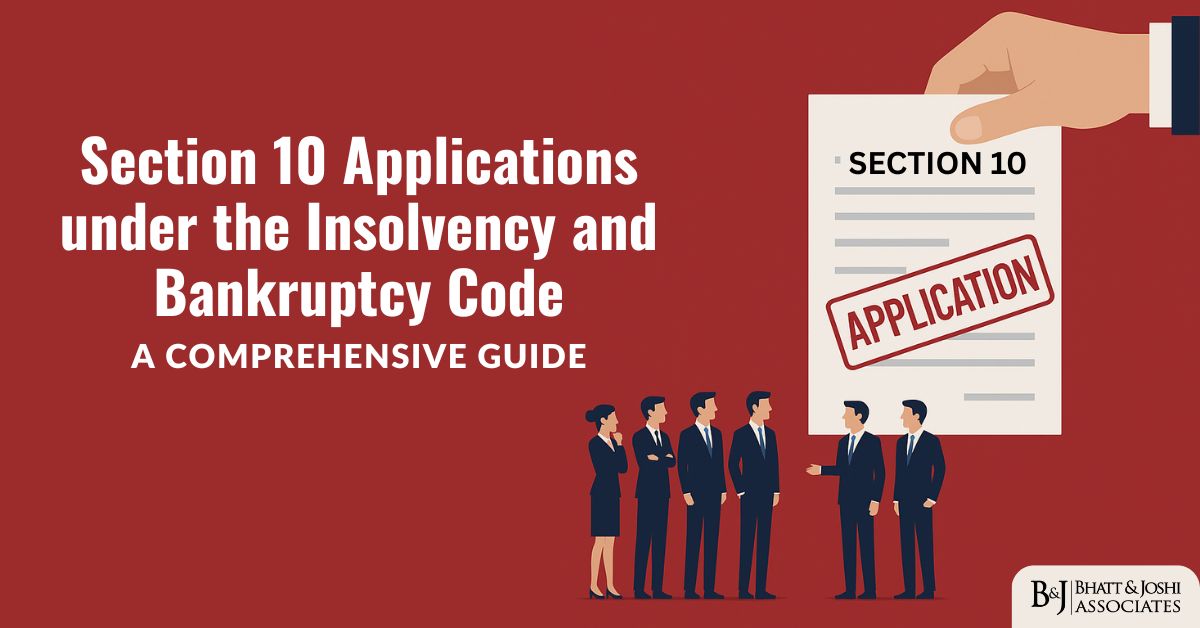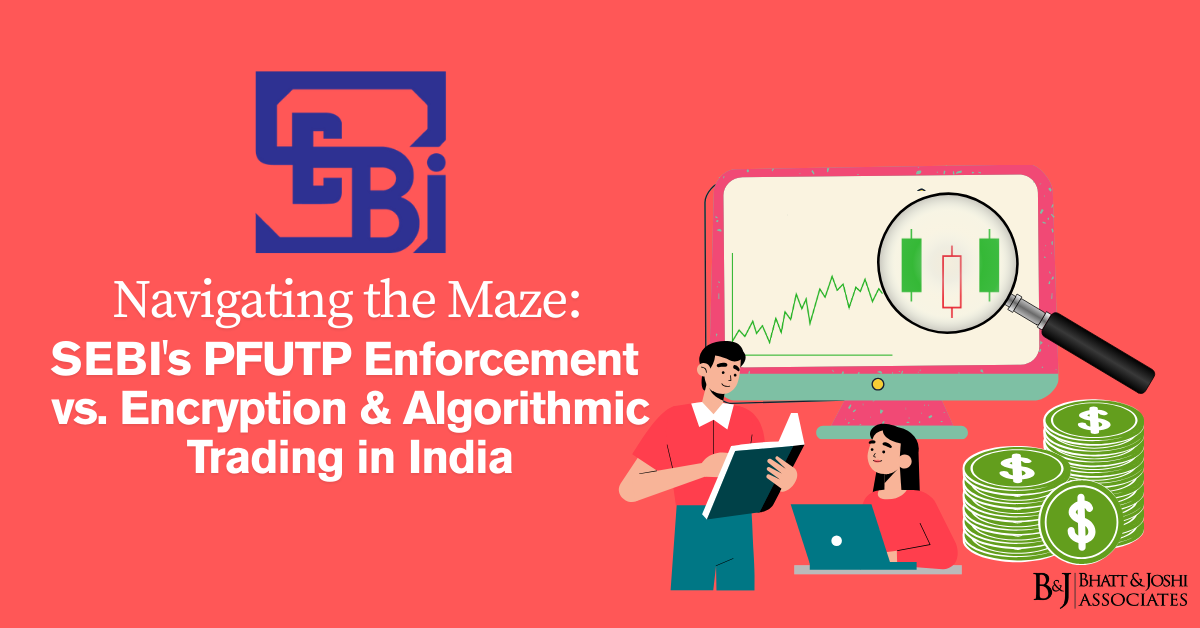Introduction
Front-running represents one of the most persistent challenges to market integrity in global financial systems. As capital markets have evolved with technological advancements and increased participation, the sophisticated abuse of information asymmetry has become more concerning for regulators worldwide. This article provides a comprehensive analysis of front-running practices, with a particular focus on India’s regulatory landscape while drawing comparisons with international approaches. By examining landmark cases, detection methodologies, and mitigation strategies, we aim to provide actionable insights for market participants, regulators, and policymakers committed to preserving market integrity.
Understanding Front-Running: Definition and Mechanics
Conceptual Framework
Front-running is fundamentally a breach of market ethics and often regulations. As defined by the Securities and Exchange Board of India (SEBI), front-running is “the usage of non-public information to directly or indirectly, buy or sell securities or enter into options or futures contracts, in advance of a substantial order, on an impending transaction, in the same or related securities or futures or options contracts, in anticipation that when the information becomes public; the price of such securities or contracts may change”.
The practice derives its name from the pre-digital era of securities trading when brokers would literally “run in front” of order carriers to execute their personal trades before large client orders. In modern markets, front-running represents the digital equivalent—leveraging privileged information about pending transactions to gain an unfair advantage.
Mechanics and Common Patterns
Front-running typically follows predictable patterns. When a market participant gains knowledge of an upcoming large order (often referred to as a “block trade”), they execute their own trades in anticipation of the price movement that will likely result when the large order is eventually executed.
Two common patterns have been identified:
- Buy-Buy-Sell (BBS) Pattern:
- Initial Buy: The front-runner purchases securities before a large buy order is executed
- Big Trader Buy: The large buy order is executed, raising the stock price
- Final Sell: The front-runner sells their position at the elevated price
- Sell-Sell-Buy (SSB) Pattern:
- Initial Sell: The front-runner sells securities before a large sell order
- Big Trader Sell: The large sell order is executed, dropping the stock price
- Final Buy: The front-runner repurchases at the lower price
The profitability of front-running stems directly from the market impact of large trades. Institutional orders of significant size naturally move prices due to supply and demand dynamics—a phenomenon that front-runners exploit for guaranteed profits at the expense of their clients or the broader market.
Regulatory Framework in India
SEBI’s Approach to Front-Running
In India, front-running is explicitly prohibited under the Securities and Exchange Board of India (Prohibition of Fraudulent and Unfair Trade Practices relating to Securities Market) Regulations, 2003 (PFUTP Regulations). Specifically, Regulation 4(2)(q) prohibits “any order in securities placed by a person, while directly or indirectly in possession of information that is not publicly available, regarding a substantial impending transaction in that securities, its underlying securities or its derivative”.
SEBI has established a three-pronged test to identify front-running violations:
- The alleged front-runner possesses material non-public information
- Such information pertains to a substantial transaction
- The order is executed in advance of the consummation of said substantial transaction
Legal Penalties and Enforcement
The consequences for front-running in India are severe. Section 15-HA of the SEBI Act prescribes penalties starting from INR 5,00,000 (approximately USD 5,734) and extending to INR 25,00,00,000 (approximately USD 28,67,000), or three times the amount of profits made from such practices, whichever is higher.
Additionally, Section 24 of the SEBI Act allows for criminal proceedings alongside civil penalties. The jurisprudential nature of front-running cases permits both civil and criminal penalties to be invoked simultaneously.
Recent Regulatory Developments
On April 30, 2024, SEBI proposed amendments to the SEBI (Mutual Funds) Regulations, 1996, establishing an institutional mechanism to prevent front-running and other market abuses. The proposed mechanism includes enhanced surveillance systems, internal control procedures, and escalation processes to identify and address specific types of misconduct.
The amendments aim to address gaps in the existing framework by requiring structured institutional mechanisms to identify and prevent market abuse, enhancing asset management companies’ responsibilities, establishing whistleblower policies, and relaxing certain record-keeping requirements for fund managers and dealers.
International Regulatory Comparison
United States Regulatory Framework
In the U.S., front-running is regulated by three main bodies:
- Financial Industry Regulatory Authority (FINRA) prohibits front-running under Rule 5270
- Securities Exchange Commission (SEC) bans the practice in its Code of Ethics, Rule 17j-1, Section D
- Commodity Futures Trading Commission (CFTC) classifies front-running as prohibited abusive trading activity in Section 37.203(a)
The SEC has been particularly aggressive in its enforcement actions, with penalties including substantial fines, disgorgement of profits, suspension or revocation of trading licenses, industry bans, and potential criminal charges in severe cases.
European and UK Approach
In the UK and EU, front-running is similarly prohibited:
- The UK’s Financial Conduct Authority (FCA) defines front-running as insider dealing in UK MAR 1.3
- The European Securities and Markets Authority categorizes it as market abuse in Article 7(1)(d) of the 2020 MAR Review Report
- In the EU, Regulation (EU) No 596/2014 Section 30 specifically addresses front-running
The FCA Handbook on Market Abuse describes front-running as “pre-positioning trading” that forms part of insider trading—trading done for personal benefit based on information concerning pending orders, taking advantage of the anticipated market impact.
Comparative Analysis
While the fundamental prohibition of front-running is consistent across major jurisdictions, differences emerge in enforcement approaches, penalty structures, and the institutional architecture of market surveillance. India’s approach aligns closely with international standards but has some distinctive features:
- Definitional Clarity: SEBI has provided more explicit definitions of what constitutes “substantial” orders in recent jurisprudence, including both qualitative assessment through the “reasonable person” test and quantitative thresholds
- Dual-Track Enforcement: India’s combination of civil and criminal penalties offers a robust deterrent framework that mirrors the approach taken in developed markets
- Focus on Prevention: The 2024 proposed amendments reflect a shift toward more structured, preventive compliance mechanisms similar to trends in developed markets
Differentiating Front-Running from Insider Trading
Fundamental Distinctions
Although both front-running and insider trading involve exploiting non-public information for trading advantages, they differ significantly in their nature and the relationships involved.
The primary distinction lies in the source of information:
- Insider Trading: Involves trading based on material, non-public information about a company. This typically involves individuals with privileged access to confidential corporate information such as executives, employees, or consultants—collectively referred to as “Connected Persons”.
- Front-Running: Involves trading based on knowledge of pending client orders. The information relates to trading activity rather than fundamental corporate developments. Front-running typically involves a breach of fiduciary duty, where a broker prioritizes their own interests over their client’s.
Areas of Overlap
Despite these distinctions, there exist scenarios where the two forms of market abuse overlap. This occurs when the source of Unpublished Price Sensitive Information (UPSI) stems from a company insider’s actions, leading to an external entity front-running a large order based on such UPSI.
For example, if an employee of a publicly traded company becomes aware of an upcoming acquisition and shares this information with both family members (who engage in insider trading) and a large institutional client who subsequently places a substantial order (leading to front-running by another market participant), both forms of market abuse can occur simultaneously.
Key Jurisprudence and Case Studies
Landmark Cases in India
SEBI vs. Kanaiyalal Baldevbhai Patel (2018)
The Supreme Court of India delivered a landmark judgment that expanded the interpretation of fraudulent activities in the securities market. The Court emphasized a broad interpretation of “fraud” under the PFUTP Regulations, recognizing front-running as a fraudulent practice under Regulation 4(2)(q).
Significantly, the judgment clarified that SEBI’s proceedings require proof based on a preponderance of probability rather than beyond a reasonable doubt, allowing inferences from circumstantial evidence and trading patterns. The Court stated that “inferential conclusion from the proved and admitted facts shall be permitted and legally justified so long as the same are reasonable and can be legitimately arrived at on a consideration of the totality of the materials”.
Evolution of the “Substantial” Transaction Threshold
A critical development in Indian jurisprudence has been the evolution of how regulators define a “substantial” transaction—a key element in establishing front-running violations. SEBI has observed that there cannot be a “straitjacket formula” to determine whether an order is substantial in nature.
In February 2023, SEBI applied a “reasonable person” test to interpret “substantial,” wherein the judgment of a reasonable person related to the volatility and impact on the stock would determine whether an order qualifies as substantial.
In another case, SEBI established a quantitative threshold, defining a “substantial” order as one comprising at least 3% of the total traded stock of a scrip and equal to or greater than 4,000 shares.+
The Ketan Parekh Front-Running Case (2023-2024)
Recently, SEBI uncovered a sophisticated front-running scheme involving former stockbroker Ketan Parekh and 21 associates. The scheme exploited non-public information about large trades planned by a significant client managing USD 2.7 trillion in assets.
SEBI’s investigation, covering January 2021 to June 2023, revealed that Parekh and his associates employed complex trading strategies to exploit their prior knowledge of the client’s impending trades. Investigators used mobile phone records and communication data to establish connections between the parties involved. Notably, a mobile number registered to Parekh’s wife played a crucial role in linking him to the fraudulent activities.
As a result, SEBI issued an interim order barring Ketan Parekh and two others from securities dealings for an unspecified period and initiated proceedings to recover illicit gains of approximately Rs 65.77 crore.
International Case Studies
SEC vs. Sergei Polevikov (U.S.)
From January 2014 to October 2019, Polevikov, a quantitative analyst at two large investment advisory firms, used non-public information about large securities trades planned by his employers to execute front-running trades in his wife’s brokerage account.
Polevikov maintained a consistent pattern of front-running over nearly six years, leveraging his access to his employers’ order and execution management systems. He took deliberate steps to conceal his activities, including failing to disclose his wife’s brokerage account and falsely certifying compliance with his employers’ ethics rules.
Detection and Enforcement Mechanisms
Surveillance Methodologies
SEBI employs sophisticated surveillance methods to detect front-running activities:
- Advanced Surveillance Systems for monitoring trade transactions
- Data Analytics applied to trade logs to identify suspicious patterns
- Real-Time Monitoring of securities markets
- Collaborative Approach with other regulators for information sharing
In its investigations, SEBI typically examines:
- Communication Records – WhatsApp chats, call recordings
- Financial Transactions – Fund transfers between suspected parties
- Relationship Analysis – Familial and professional connections
Evidential Standards and Proof
The evidential standard in front-running cases typically relies on the “preponderance of probability” rather than “beyond reasonable doubt”. This allows regulatory bodies to establish violations based on circumstantial evidence such as:
- Pattern Analysis – Recurring trading behaviors
- Statistical Evidence – Probability of trading coincidences
- Connectedness between alleged entities
- Behavioral Consistency – Repetitive actions across multiple instances
- Transaction Records – Timing and sequence of trades
The emerging use of artificial intelligence in surveillance systems presents both opportunities for more effective detection and challenges in terms of evidence admissibility and interpretability.
Economic Impact of Front-Running
Market Integrity and Efficiency
Front-running has several detrimental effects on market functioning:
- Information Asymmetry: By exploiting non-public information, front-runners create an uneven playing field that undermines fair price discovery.
- Price Distortion: By inserting additional trades before large orders, front-runners can amplify price movements, potentially leading to artificial volatility.
- Transaction Costs: The practice effectively imposes a hidden “tax” on legitimate market participants, especially institutional investors whose transaction costs increase due to the price impact created by front-runners.
- Reduced Liquidity: The perception of widespread front-running can deter participation in markets, particularly by institutional investors who may seek alternative trading venues or execution methods to minimize their market impact.
Academic Perspectives
Research has highlighted how front-running represents a form of rent-seeking that provides no social benefit. In a notable paper published in the Proceedings of the National Academy of Sciences, it was argued that front-running creates “a special result: All of the transaction costs of the extra frontrunning are borne by the unsophisticated traders, with no gain to the sophisticates. This paper hence provides a specific instance of inefficient financial transactions and excessive rent seeking with gains to no one”.
This perspective underscores that front-running is not merely a redistribution of wealth but a net social loss, as it increases transaction costs without improving price efficiency or information discovery.
Risk Mitigation Strategies and Policy Recommendations
Institutional Mechanisms for Prevention
SEBI’s proposed amendments to the Mutual Funds Regulations represent a significant step toward institutionalizing front-running prevention:
- Structured Surveillance Systems: Implementing technologies and procedures specifically designed to identify suspicious trading patterns
- Internal Control Procedures: Establishing clear protocols for handling sensitive information about trading intentions
- Escalation Processes: Creating formal channels for reporting suspected front-running activities
- Whistleblower Policies: Encouraging the reporting of potential violations through protected channels
Technological Solutions to Combat Front-Running
Advanced technologies offer new possibilities for detecting and preventing front-running:
- Artificial Intelligence and Machine Learning: These technologies can analyze vast amounts of trading data to identify patterns indicative of front-running, potentially catching sophisticated schemes that might evade traditional surveillance methods.
- Blockchain and Distributed Ledger Technology: Immutable trade records could increase transparency and make it more difficult to conceal front-running activities.
- Anonymous Trading Mechanisms: Pre-trade anonymity features can help institutional investors conceal their trading intentions, reducing the risk of information leakage that enables front-running.
Best Practices for Market Participants
- Information Barriers: Implementing robust “Chinese walls” between trading departments and other units that might have access to information about client orders.
- Code of Ethics: Developing and enforcing strong ethical guidelines that explicitly address front-running and related market abuses.
- Training and Awareness: Regular training programs to ensure all employees understand what constitutes front-running and the severe consequences of engaging in such practices.
- Monitoring Systems: Implementing internal surveillance systems to detect potential front-running activity by employees.
Critical Analysis and Future Outlook
Challenges in Enforcement
Despite robust regulatory frameworks, several challenges persist in effectively combating front-running:
- Technological Sophistication: As trading technologies advance, front-runners develop increasingly sophisticated methods to conceal their activities, creating a technological arms race between regulators and market abusers.
- Cross-Border Coordination: In globally interconnected markets, front-running schemes can span multiple jurisdictions, complicating investigation and enforcement efforts.
- Definitional Boundaries: The evolving nature of market structures continually raises new questions about what constitutes “substantial” orders or “material” information.
- Balancing Innovation and Integrity: Overly restrictive regulations might impede legitimate market-making activities and innovation, while lax enforcement enables abusive practices.
Evolving Regulatory Landscape
Looking forward, several trends are likely to shape the regulatory approach to front-running:
- Regulatory Convergence: As global markets become more integrated, we may see greater harmonization of regulatory definitions and enforcement approaches across jurisdictions.
- AI-Enhanced Surveillance: Regulatory bodies will increasingly deploy sophisticated artificial intelligence tools to detect complex front-running schemes that might evade traditional surveillance.
- Preemptive Compliance: The regulatory focus may shift from punitive measures toward requiring market participants to implement more robust preventive systems, similar to SEBI’s recent proposals.
- New Market Structures: The rise of alternative trading systems, decentralized finance, and new asset classes will create novel challenges in defining and detecting front-running.
Conclusion
Front-running remains a persistent challenge to market integrity in both India and global financial markets. As the Ketan Parekh case demonstrates, even sophisticated schemes can eventually be uncovered through diligent investigation and advanced surveillance techniques.
India’s regulatory approach, particularly SEBI’s recent initiatives to establish institutional mechanisms for prevention, aligns with global best practices while addressing country-specific market dynamics. The dual emphasis on both detection and prevention reflects a mature understanding that maintaining market integrity requires both deterrence through enforcement and fostering a culture of compliance.
For market participants, the message is clear: the regulatory scrutiny of front-running continues to intensify, with increasingly sophisticated detection methods and severe penalties for violations. For investors, these enforcement actions should provide confidence that regulatory bodies are committed to ensuring fair and efficient markets.
As capital markets continue to evolve technologically and structurally, the definition and regulation of front-running will likely adapt as well. The fundamental principle, however, remains unchanged—exploiting privileged position and information to disadvantage others undermines the integrity of markets and ultimately harms all participants.
Written by : Aditya bhatt
Associate: Bhatt and Joshi Associates














